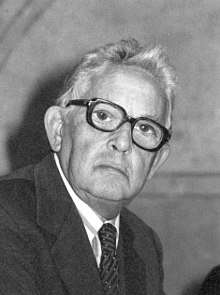Goffredo Petrassi
Goffredo Petrassi (16 July 1904 – 3 March 2003) was an Italian composer of modern classical music, conductor, and teacher. He is considered one of the most influential Italian composers of the twentieth century.[1]

Life
Petrassi was born at Zagarolo, near Rome. At the age of 15 he began to work at a music shop to supply his family's financial needs, and became fascinated by music. In 1928, he entered the Santa Cecilia Conservatory in Rome to study organ and composition. In 1934, composer Alfredo Casella conducted Petrassi's Partita for orchestra at the ISCM festival in Amsterdam.
Later, Petrassi became musical director of the opera house La Fenice, and from 1959 taught composition at the Santa Cecilia Conservatory and at the Salzburg Mozarteum. Petrassi had many famous students, including Franco Donatoni, Aldo Clementi, Cornelius Cardew, Ennio Morricone, Karl Korte, Boris Porena, Norma Beecroft, Mario Bertoncini, Ernesto Rubin de Cervin, Eric Salzman, Kenneth Leighton, Peter Maxwell Davies, Michael Dellaira, Armando Santiago, and Richard Teitelbaum. See: List of music students by teacher: N to Q#Goffredo Petrassi. Petrassi died in Rome at the age of 98.
Music
Petrassi's early work was part of an attempt by several Italian composers to create a national "Italian" revival in classical music, corresponding to the romantic work of Germans such as Richard Wagner. During this time, his work was characteristically neoclassical in style, influenced by Bartók, Hindemith and Stravinsky.
In later years, Petrassi's open musical mind and acute personality led him to experiment with different post-Webernian influences and a wide range of poetic materials, from Latin hymns to Ariosto's La follia d'Orlando and Ritratto di Don Chisciotte (Portrait of Don Quixote), based on the Miguel de Cervantes literary character. All these influences are present in a remarkable series of eight Concerti for Orchestra which he composed between the late 1930s and the late 1970s.
Petrassi stopped composing in 1986 due to increasing loss of eyesight.
Works
- Partita for Orchestra (1932)
- Preludio, Aria, e Finale for Cello and Piano (1933)
- Concerto for Orchestra (1934)
- Psalm IX (1934–36)
- Piano Concerto (1936–39)
- Magnificat (1939–40)
- Coro di Morti (1941)
- Quatro inni Sacri (1942-1950)
- La follia di Orlando (1942–43) (also as a symphonic suite)
- Ritratto di Don Chisciotte (1945)
- Il Cordovano (1948)
- Morte dell'aria (1950)
- Noche Oscura (1950–51)
- Concerto for Orchestra No. 2 (1951)
- Concerto for Orchestra No. 3 (1953)
- Concerto for Orchestra No. 4 (1954)
- Concerto for Orchestra No. 5 (1955)
- Concerto for Orchestra No. 6 (1957)
- Serenata (1958)
- String Quartet (1958)
- Flute Concerto (1960)
- Concerto for Orchestra No. 7 (1963–64)
- Concerto for orchestra No. 8 (1970–72)
- Orationes Christi (1975)
- Kyrie (1990)
Notes
- Petrassi, Goffredo. (2008). In Encyclopædia Britannica. Retrieved March 14, 2008, from Encyclopædia Britannica Online: http://www.britannica.com/eb/article-9059491
External links
- The Goffredo Petrassi Institute (in Italian)
- Goffredo Petrassi Un maestro del Novecento (in Italian)
- Photo of Petrassi at Find a Grave
- Guardian obituary